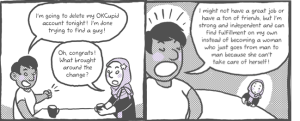
A person with long hair stands against a chainlink fence, staring at the camera with a serious expression.
Alright, folks. We’ve got to have a chat about cultural voyeurism.
Cultural voyeurism is a problematic issue that’s a little difficult to describe. It’s also something that many of us – including well-intentioned allies – do quite often. Which is exactly why we need to learn about it!
What is cultural voyeurism? Why is it dangerous? And how might we be perpetuating it?
Let’s ease into this a bit. I’d like to paraphrase a fable from Namjoshi and Hanscombe’s “Lost Species” in Flesh and Paper (1986) that captures the logic of cultural voyeurism:
“An intrepid naturalist once stumbled upon a tribe of exotic creatures. They looked a bit like rabbits and a bit like piglets, but they might have been apes or possibly hyenas. ‘Aha!’ said the naturalist, ‘A veritable find! I shall be famous.’
“He took a number of photographs and dashed back to civilization. He wanted the millionaires to equip an expedition. But the millionaires looked dubious. ‘What are they good for?’ they inquired. But the naturalist had forgotten to ask. He returned to the monkeys, or perhaps they were piglets, and said to them, ‘What are you good for?’ But they said nothing at all.
“’What I mean is, is your flesh good to eat? Is your fur warm?’ ‘No,’ they murmured. ‘We do nothing useful.’ So the naturalist left never to return, and to the best of my knowledge the purposeless pandas, or perhaps they were pangolins, still prosper.”
Cultural voyeurism is the practice of seeking some kind of gratification by objectifying a culture different from one’s own.
This often happens while traveling. And, from my research in West Africa to my teaching in Aotearoa, New Zealand, I’ve encountered many instances of such objectification, particularly relating to tourism.
Of course, there are also all kinds of non-touristy, everyday examples in which many people engage in cultural voyeurism. And most of the time, these folks are well-meaning. Most of the time, they’re trying to practice anti-racism and cultural exchange.
Unfortunately, even the best intentions can be problematic.
So, what we need to do is recognize cultural voyeurism and instead engage in actual emancipatory action.
What Is Cultural Voyeurism?
Cultural voyeurism is objectification. That is, something dynamic and changing – like culture – is turned into an object, a thing. And the cultures themselves have little control over this process.
Colonial, white supremacist imaginations frame such problematic objectification. Consequently, this limits how much people of color can determine if, let alone how, white people objectify them.
But cultural voyeurism is even more than that.
It is also the consumption of objectified cultural practices and symbols. And typically, there is little to no benefit to those of “other” cultures.
Tourism is a field where this is quite common. Many of us with the privilege to travel have probably confronted cultural voyeurism ourselves. And if we’re being honest, we’ve probably done it, either without meaning to or with the best intentions.
Think of walking down an “old town” market while on a vacation. Imagine eavesdropping on locals speaking in their native languages. Or picture walking through crowded passageways, taking photos (maybe without asking permission?) of vendors or their wares.
Have you giggled at the prospect of haggling over something “exotic?” Have you gone on a “slum safari,” taking a van through a city’s low-income neighborhoods?
I can think of some of my own experiences with cultural voyeurism.
I recall predominantly white, European and American tourists traveling in “fabled” Timbuktu, Mali who have failed to recognize that it’s a contemporary town with a complex social and political structure. Instead, they’ve wanted to be entertained, on their own terms, by “traditional” encounters with the nomadic “blue men of the Sahara.”
On the other side of the world, I’ve met similar tourists in Aotearoa, New Zealand who obnoxiously gawk at Māori tā moko (“tattoos”) without respecting that these designs are taonga (“treasures”) which both represent a person’s mana (power and connection to the gods) as well as the wearer’s whakapapa (“genealogy”). Tā moko, therefore, are considered tapu (sacred) and are associated with a set of rituals and a general expectation of deference and respect for the art form.
Cultural voyeurism takes many forms beyond tourism, though.
Consider clothing stores, like Forever 21, that sell items that have a so-called “Native American” or “African” feel to them.
Consider music festivals, like Coachella, were many people adopt the media’s version of Native American headpieces.
Have you ever attended a rave or party that has appropriated Indian Holi with their spray colors? Have you ever eaten at a Mexican restaurant where only the staff are Mexican, whereas the owner and/or head chef is white?
These are all examples of cultural voyeurism, and they’re actually quite dangerous, particularly because they (sometimes quite subtly) perpetuate racism.
How Is Cultural Voyeurism Dangerous?
Cultural voyeurism reinforces white supremacy.
By objectifying different groups, it misrepresents non-white cultures and cultural practices.
Rather than cultivating a situation in which people of color can represent themselves (to white folks), cultural voyeurism is a relationship in which white consumers set the terms.
Consequently, the representations that are most often rewarded are distortions that are largely framed by imperial, colonial, and racist imaginations.
As I’ve been told, a running “joke” among tour operators throughout sub-Saharan Africa, for example, concerns “cultural safaris.” After rushing out of cosmopolitan capital cities, foreign tourists often bus to rural communities, intent upon witnessing an exotic “ethnic” show.
There, a carefully choreographed performance takes place, typically involving drumming and shirtless dancers adorned with painted designs. After a couple of hours, the tourists depart, at which point the dancers wash off the paint, change into t-shirts and jeans and turn on the radio.
I’ve spoken to a number of folks who have taken cultural or slum “safaris.” And, they clearly often mean well. The same goes for those who have purchased “Native” headbands and/or “African” prints.
In fact, many often consider going on such a tour or wearing such clothing as an act of solidarity. Or as a way of financing marginalized communities.
Many don’t recognize that these behaviors can actually cause significant harm.
Even if intended otherwise, those who engage in cultural voyeurism really aren’t supporting communities of color. For the support itself remains contingent upon such communities representing themselves in specific – often static – ways that are mainly gratifying only to white audiences.
In other words, cultural safaris, “Native” prints, “ethnic” parties, and so on mainly serve to reinforce, rather than problematize, how we perceive communities different from our own.
Furthermore, objectified groups rarely benefit financially from this kind of “investment.”
Regarding Native or African prints, for example, they typically receive no royalties. Consider Urban Outfitters. Without seeking permission, despite public and legal injunctions to stop, and without providing Navajo communities financial reimbursement, Urban Outfitters prefers to violate federal and state trademark laws, and the Indian Arts and Crafts Act, in order to profit from the sale of Navajo designs.
And, regarding cultural performances, payments to performers are often crumbs compared to the profits collected by the owners and managers of tourism companies (most of whom are not members of the objectified communities themselves).
As such, cultural voyeurism tends to reinforce both racist perceptions and racist structures that mainly serve to profit already wealthy outsiders at the expense of marginalized communities.
Why Don’t We Always Recognize Cultural Voyeurism?
In my experience, cultural voyeurism rarely reinforces racism in an explicit sense. However, it often does so implicitly.
Cultural voyeurism is everywhere. We’re surrounded by it. We might even (inadvertently) participate in it. So, we might not even recognize its presence in our everyday lives.
Many people confuse cultural voyeurism with cultural exchange – but, when one objectifies another culture or person, when they seek gratification while maintaining distance, that’s not exchange.
Walking through a market, attending a cultural performance, wearing a Native American print, and so on might seem like real interaction with a community different from one’s own.
But if we think about, where’s the exchange, really?
I know, this is frustrating. Very few of us want to cause actual harm or participate in oppressive behaviors.
Why does it seem, then, that so many of us sometimes still fall into this same cultural voyeurism trap?
Well, those with the privilege to engage in cultural voyeurism often also have the privilege to dismiss critiques of cultural voyeurism in general, or their individual behavior in particular.
We should actively listen to and empathize with those who call us in or out. However, if we’re being honest, most of us don’t. Or, we become defensive and resist it because it’s really, really uncomfortable.
It’s embarrassing to acknowledge that we’ve done something racist, especially if we strive towards allyship. So, rather than admit to it and engage in the necessary work to improve ourselves and our engagement with others, many of us disregard the criticisms we confront.
I’ve encountered these reactions to cultural voyeurism plenty of times:
- You’re being too sensitive.
- I’m just having some fun.
- So-and-so said it was okay.
Privileging our embarrassment over (being called out for) our actions, we actually reinforce white supremacy. Because we try to convince ourselves that our actions aren’t racist, we fail to recognize that many of us continue to reinforce cultural voyeurism while silencing those who suffer its negative impacts.
An Alternative: Cultural Exchange
I realize that most of us don’t mean to engage in cultural voyeurism. And most of us certainly don’t intend to perpetuate racism.
But – and this is painful, I know – best intentions don’t really matter. Because best intentions can still cause harm. They can still reinforce problematic systems of oppression.
Even if we mean well, we must be willing to take responsibility for our missteps. We also must be willing to change our attitudes and behaviors. Rather than continuing to perpetuate racism through cultural voyeurism, therefore, we must consider cultural exchange as an alternative.
Cultural exchange is mutually and respectfully engaging with another culture.
It’s about sharing, not taking. It’s about being invited – on their terms, not yours – to participate in different cultural practices.
And it’s about listening, not presuming or speaking over. Those who really want to support historically marginalized communities must take seriously what members of those communities have to say.
Of course, we should stop engaging in cultural voyeurism in the first place. That way we don’t harm other communities, nor do we put them in the awkward position of either having to ignore our implicit racism or having to call it out.
But, if we do unintentionally commit an act of cultural voyeurism, the least we can then do is listen to those who ask us to stop and work hard to prevent it in the future.
Then, through real exchange, we can practice actual anti-racist work. By really engaging with different communities, we can better support their empowerment and liberation.
[do_widget id=’text-101′]
Andrew Hernández is a Contributing Writer for Everyday Feminism. He is a public anthropologist and teacher, completing his PhD in cultural anthropology at the Graduate Center, City University of New York. Andrew bases his research out of West Africa and the Sahara, working on issues of human rights, crisis and religion. A former adjunct lecturer, he is now a Professional Teaching Fellow at the University of Auckland in New Zealand. You can follow him on Twitter @AndrewHernann or at his website www.AndrewHernann.com.
Search our 3000+ articles!
Read our articles about:
Our online racial justice training
Used by hundreds of universities, non-profits, and businesses.
Click to learn more




















